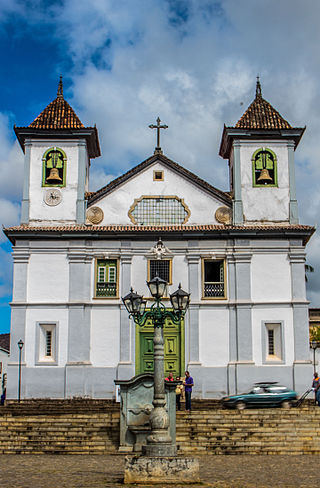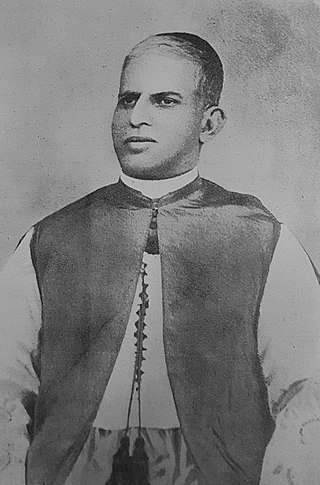
Henrique Dias (died 8 June 1662) [1] was a Portuguese soldier and militia leader born in the colony of Brazil. There is no consensus among historians whether he was born free or captive.

Henrique Dias (died 8 June 1662) [1] was a Portuguese soldier and militia leader born in the colony of Brazil. There is no consensus among historians whether he was born free or captive.
Dias led a military regiment composed of enslaved and freed slaves and was known as "Governor of the Blacks" in 1636. [2] Dias defended Portuguese settlements from Dutch forces and played important roles in the First and Second Battles of Guararapes, [3] [4] in the defense of Salvador, Bahia, and to restore Portuguese control over Pernambuco. [2] Dias' title was expanded to "Governor of All Creoles, Blacks, and Mulattoes," [5] [6] in 1639. [2]
It is debated whether Dias received nobility status within Brazil, some believe Dias was granted Knighthood in The Order of Christ, [7] while others debate Dias never received this title [8] and requested knighthood be granted to the men who marry his daughters. [9] Dias traveled to Portugal and petitioned the crown to grant his requests. Dias requested the enslaved blacks who served with him be freed should have "all the rights and privileges of white units". [10] Dias also requested to be compensated for his efforts and allowed to serve as long as he wished. [8]
In Brazil, Pardo is an ethnic and skin color category used by the Brazilian Institute of Geography and Statistics (IBGE) in the Brazilian censuses. The term "pardo" is a complex one, more commonly used to refer to Brazilians of mixed ethnic ancestries.

Afro-Brazilians are Brazilians who have predominantly sub-Saharan African ancestry. Most members of another group of people, multiracial Brazilians or pardos, may also have a range of degree of African ancestry. Depending on the circumstances, the ones whose African features are more evident are always or frequently seen by others as "africans" - consequently identifying themselves as such, while the ones for whom this evidence is lesser may not be seen as such as regularly. It is important to note that the term pardo, such as preto, is rarely used outside the census spectrum. Brazilian society has a range of words, including negro itself, to describe multiracial people.

The Second Battle of Guararapes was the second and decisive battle in a conflict called the Pernambucana Insurrection, between Dutch and Portuguese forces in February 1649 at Jaboatão dos Guararapes in Pernambuco. The defeat convinced the Dutch "that the Portuguese were formidable opponents, something which they had hitherto refused to concede." The Dutch still retained a presence in Brazil until 1654 and a treaty was signed in 1661.
Luís Romano de Madeira Melo was a bilingual poet, novelist, and folklorist who has written in Portuguese and the Capeverdean Crioulo of Santo Antão.

Antônio Filipe Camarão was an indigenous soldier from the Potiguara tribe near the Rio Grande do Norte area of the Portuguese colony of Brazil. His original tribal name was Poti, which means "prawn". He was born in the neighbourhood of Igapó, in Natal, or, according to some other historians, in the state of Pernambuco, or in Aldeia Velha.

The Archdiocese of São Paulo is a Latin Metropolitan Archbishopric of the Roman Catholic Church in Brazil.
Bom-Crioulo: The Black Man and the Cabin Boy is a novel by the Brazilian writer Adolfo Caminha, first published in 1895. An English translation by E.A. Lacey was published in 1982 by Gay Sunshine.

Mestiço is a Portuguese term that referred to persons born from a couple in which one was an aboriginal person and the other a European.

Brazilian society is made up of a confluence of people of Indigenous, Portuguese, and African descent. Other major significant groups include Italians, Spaniards, Germans, Lebanese, and Japanese.

The Roman Catholic Archdiocese of Florianópolis is an archdiocese located in the city of Florianópolis in Brazil.

The Roman Catholic Archdiocese of Mariana is an archdiocese based in the city of Mariana in the Brazilian state of Minas Gerais.
The Roman Catholic Diocese of São João da Boa Vista is a diocese located in the city of São João da Boa Vista in the Ecclesiastical province of Ribeirão Preto in Brazil.

The Roman Catholic Diocese of Barra do Piraí–Volta Redonda is a diocese located in the cities of Barra do Piraí and Volta Redonda in the Ecclesiastical province of São Sebastião do Rio de Janeiro in Brazil.

The Roman Catholic Diocese of Nova Iguaçu is a diocese located in the city of Nova Iguaçu in the Ecclesiastical province of São Sebastião do Rio de Janeiro in Brazil.

Msgr Sebastião Rodolfo Dalgado was a Catholic priest, academic, university professor, theologian, orientalist, and linguist from Portuguese Goa.

The Tietê Bus Terminal is the largest bus terminal in Latin America, and the second largest in the world, after the Port Authority Bus Terminal in New York City. The terminal is located in the Santana district in the city of São Paulo, Brazil. The official name in Portuguese is Terminal Rodoviário Governador Carvalho Pinto, named after Carlos Alberto Alves de Carvalho Pinto, a former Governor of the State of São Paulo.
Racism has been present in Brazil since its colonial period and is pointed as one of the major and most widespread types of discrimination, if not the most, in the country by several anthropologists, sociologists, jurists, historians and others. The myth of a Racial Democracy, a term originally coined by Brazilian sociologist Gilberto Freyre in his 1933 work Casa-Grande & Senzala, is used by many people in the country to deny or downplay the existence and/or the broad extension of racism in Brazil.

Pardos is a term used in the former Portuguese and Spanish colonies in the Americas to refer to the triracial descendants of Southern Europeans, Indigenous Americans and West Africans. In some places they were defined as neither exclusively mestizo, nor mulatto, nor zambo. In colonial Mexico, pardo "became virtually synonymous with mulatto, thereby losing much of its Indigenous referencing". In the eighteenth century, pardo might have been the preferred label for blackness. Unlike negro, pardo had no association with slavery. Casta paintings from eighteenth-century Mexico use the label negro, never pardo, to identify Africans paired with Spaniards.

Nelson Sargento OMC was a Brazilian composer, singer, Brazilian popular music researcher, visual artist, actor, and writer.
Tomé Ferreira da Silva was a Roman Catholic prelate and is a priest in the Latin Rite. He was Bishop of the Roman Catholic Diocese of São José do Rio Preto from 16 November 2012 until 18 August 2021. When ordained a bishop, the diocese he led had between 701,000 and 958,000 Roman Catholics, or almost 75% of the population.